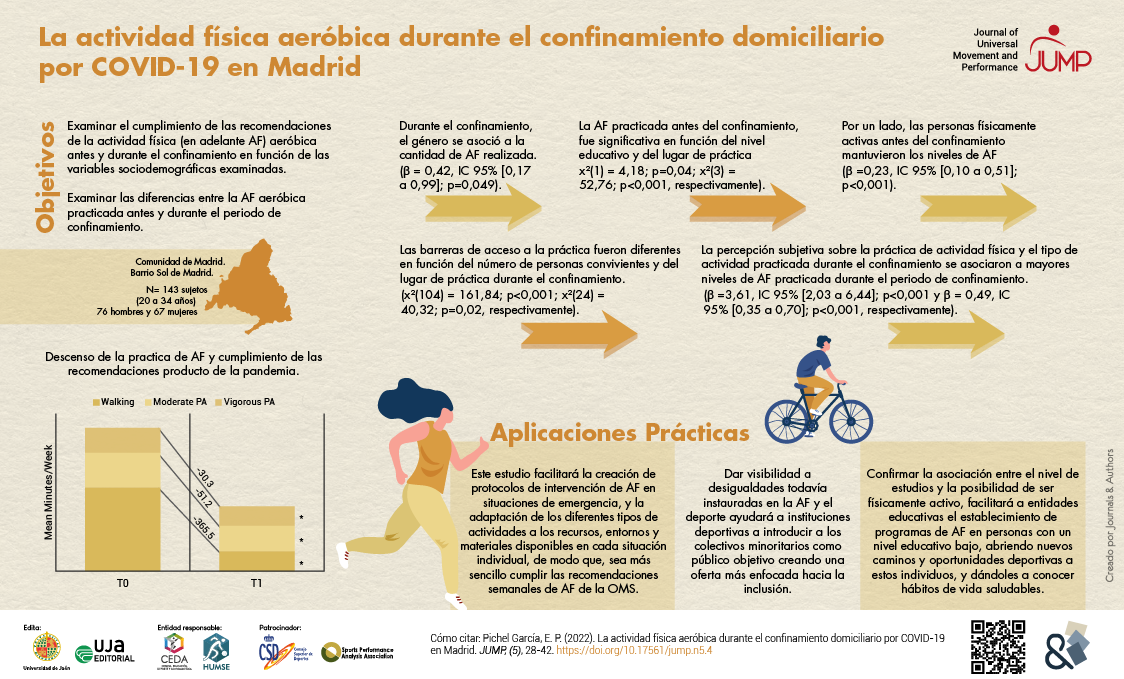La actividad física aeróbica durante el confinamiento domiciliario por COVID-19 en Madrid
DOI:
https://doi.org/10.17561/jump.n5.4Palabras clave:
Actividad Física, Confinamiento, COVID-19, Género, BarrerasResumen
Se pretendió evaluar los cambios de la Actividad Física (AF) aeróbica en Madrid durante el confinamiento domiciliario por COVID-19, en función de variables sociodemográficas. Se encuestó online a 225 personas, de entre 20 y 34 años, residentes en el barrio de Sol de Madrid. El análisis de los datos tuvo en cuenta el cumplimiento de las recomendaciones de AF aeróbica antes y después del confinamiento. Durante el confinamiento, el género se asoció a la cantidad de AF realizada (β = 0,42, IC 95% [0,17 a 0,99]; p=0,049). También, la AF practicada antes del confinamiento, fue significativa en función del nivel educativo y del lugar de práctica x2(1) = 4,18; p=0,04; x2(3) = 52,76; p<0,001, respectivamente). Además, las barreras de acceso a la práctica fueron diferentes en función del número de personas convivientes y del lugar de práctica durante el confinamiento (x2(104) = 161,84; p<0,001; x2(24) = 40,32; p=0,02, respectivamente). Por un lado, las personas físicamente activas antes del confinamiento mantuvieron los niveles de AF durante el (β =0,23, IC 95% [0,10 a 0,51]; p<0,001). Sin embargo, la percepción subjetiva sobre la práctica de actividad física y el tipo de actividad practicada durante el confinamiento se asociaron a mayores niveles de AF practicada durante el periodo de confinamiento (β =3,61, IC 95% [2,03 a 6,44]; p<0,001 y β = 0,49, IC 95% [0,35 a 0,70]; p<0,001, respectivamente). Previamente al confinamiento ya existían diferencias en las variables de edad, género o nivel de estudios, en la de AF aeróbica. Con la cuarentena se han exacerbado considerablemente estas diferencias en los niveles de AF aeróbica. La AF descendió, especialmente en mujeres y en personas sin estudios universitarios, durante el confinamiento.
Referencias
Alvira, F. (2000). Diseños de investigación social: criterios operativos. En M. García Ferrando, J. Ibáñez, y F. Alvira (Eds.), El análisis de la realidad social. Métodos y técnicas de investigación (pp. 99-125). Madrid: Alianza Editorial.
Asamblea Médica Mundial. (1964). Declaración de Helsinki de la AMM – Principios éticos para las investigaciones médicas en seres humanos – WMA – The World Medical Association. Asamblea Medica Mundial. https://www.wma.net/es/policies-post/declaracion-de-helsinki-de-la-amm-principios-eticos-para-las-investigaciones-medicas-en-seres-humanos/
Asociación Médica Mundial. (2015). Declaración de Helsinki. Investigación médica en seres humanos. Asociación Médica Mundial. https://www.wma.net/es/que-hacemos/etica-medica/declaracion-de-helsinki/
Banco de datos Ayuntamiento de Madrid. (2020). Población por distrito y barrios. Ayuntamiento de Madrid. http://www-2.munimadrid.es/TSE6/control/seleccionDatosBarrio
Bowes, A., Lomax, L., & Piasecki, J. (2020). The impact of the COVID-19 lockdown on elite sportswomen. Managing Sport and Leisure, 1-17. https://doi.org/10.1080/23750472.2020.1825988
Bryman, A. (2004). Social Research Methods. Oxford University Press.
Bull, F. C., Al-Ansari, S. S., Biddle, S., Borodulin, K., Buman, M. P., Cardon, G., Carty, C., Chaput, J. P., Chastin, S., Chou, R., Dempsey, P. C., DiPietro, L., Ekelund, U., Firth, J., Friedenreich, C. M., Garcia, L., Gichu, M., Jago, R., Katzmarzyk, P. T., Lambert, E., Leitzmann, M., Milton, K., Ortega, F., Ranasinghe, C., Stamatakis, E., Tiedemann, A., Troiano, R., Van der Ploeg, H., Wari, V., & Willumsen, J. F. (2020). World Health Organization 2020 guidelines on physical activity and sedentary behaviour. British Journal of Sports Medicine, 54(24), 1451-1462. https://doi.org/10.1136/bjsports-2020-102955
Carriedo, A., Cecchini, J. A., Fernandez-Rio, J., & Méndez-Giménez, A. (2020). COVID-19, Psychological Well-being and Physical Activity Levels in Older Adults During the Nationwide Lockdown in Spain. American Journal of Geriatric Psychiatry, 28(11), 1146-1155. https://doi.org/10.1016/j.jagp.2020.08.007
Castañeda-Babarro, A., Coca, A., Arbillaga-Etxarri, A., & Gutiérrez-Santamaría, B. (2020). Physical activity change during COVID-19 confinement. International Journal of Environmental Research and Public Health, 17(18), 1–10. https://doi.org/10.3390/ijerph17186878
Cea D'Ancona, M. Á. (2001). Fundamentos y aplicaciones en metodología cuantitativa. Madrid: Síntesis.
Cea D'Ancona, M. Á. (2004). Métodos de encuesta. Teoría y práctica, errores y mejora. Madrid: Síntesis.
Chouchou, F., Augustini, M., Caderby, T., Caron, N., Turpin, N. A., & Dalleau, G. (2020). The importance of sleep and physical activity on well-being during COVID-19 lockdown: reunion island as a case study. Sleep Medicine, 77. https://doi.org/10.1016/j.sleep.2020.09.014
Clemente, A. L., Del Hierro, D., Jimémez, V., Sacedón, D., Santacruz, J. A., & Cerro, D. (2017). Conocimiento de los beneficios de la actividad físico-deportiva en las personas mayores según variables socio-demográficas. Journal of Sport and Health Research, 9(3), 339-346. http://www.journalshr.com/papers/Vol%209_N%203/JSHR%20V09_3_6.pdf
Constandt, B., Thibaut, E., De Bosscher, V., Scheerder, J., Ricour, M., & Willem, A. (2020). Exercising in times of lockdown: An analysis of the impact of COVID-19 on levels and patterns of exercise among adults in Belgium. International Journal of Environmental Research and Public Health, 17(11), 1-10. https://doi.org/10.3390/ijerph17114144
Deng, J., Zhou, F., Hou, W., Silver, Z., Wong, C. Y., Chang, O., Huang, E., & Zuo, Q. K. (2021). The prevalence of depression, anxiety, and sleep disturbances in COVID-19 patients: a meta-analysis. Annals of the New York Academy of Sciences, 1486(1), 90-111. https://doi.org/10.1111/nyas.14506
Espada, M., Martín, M., Jiménez, V., Moscoso, D., Jiménez-Beatty, E., & Rivero, A. (2018). Leisure sports habits in spanish adults: gender and social differences habitos deportivos de ocio en adultos españoles: género y diferencias sociales. Revista de Ciencias Sociales, 13(2), 495-513. https://doi.org/10.14198/OBETS2018.13.2.02
Füzéki, E., Groneberg, D. A., & Banzer, W. (2020). Physical activity during COVID-19 induced lockdown: Recommendations. Journal of Occupational Medicine and Toxicology, 15(1), 25. https://doi.org/10.1186/s12995-020-00278-9
Gallè, F., Sabella, E. A., Ferracuti, S., De Giglio, O., Caggiano, G., Protano, C., Valeriani, F., Parisi, E. A., Valerio, G., Liguori, G., Montagna, M. T., Romano Spica, V., Da Molin, G., Orsi, G. B., & Napoli, C. (2020). Sedentary Behaviors and Physical Activity of Italian Undergraduate Students during Lockdown at the Time of CoViD−19 Pandemic. International Journal of Environmental Research and Public Health, 17(17), 6171. https://doi.org/10.3390/ijerph17176171
García Ferrando, M., Ibáñez, J. y Alvira, F. (Eds.). (2000). El análisis de la realidad social. Métodos y técnicas de investigación. Madrid: Alianza Editorial.
Guicciardi, M., & Pazzona, R. (2020). The Rebooting in Sports and Physical Activities After COVID-19 Italian Lockdown: An Exploratory Study. Frontiers in Psychology, 11, 3089. https://doi.org/10.3389/fpsyg.2020.607233
Hattery, A. J. (2010). Feminist Theory and the Study of Sport. Champaign, IL: Human Kinetics.
Hew-Butler, T., Smith-Hale, V., Van Sumeren, M., Sabourin, J., & Levy, P. (2020). Is exercise the best medicine during a COVID-19 pandemic?. International Journal of Environmental Research and Public Health, 17(16). https://doi.org/10.3390/ijerph17165730
Jiménez García, S. (2020, October 30). Protección de Datos de Carácter Personal. https://www.boe.es/legislacion/codigos/codigo.php?id=55&modo=2¬a=0
Maestre-Miquel, C., Regidor, E., Cuthill, F., & Martínez, D. (2015). Desigualdad en la prevalencia de sedentarismo durante el tiempo libre en población adulta española según su nivel de educación. Diferencias entre 2002 y 2012. Revista Española de Salud Pública, 89(3), 259-269. http://www.redalyc.org/articulo.oa?id=17039664005
Martín Rodríguez, M., Mateos, M. E., Moscoso Sánchez, D., Jiménez-Beatty, J. E., Santacruz, J. A., & Jiménez Díaz, V. (2018). La práctica de actividad física y deporte: una demanda sociológicamente construida. Revista de Humanidades, 34, 87-105.
Martínez del Castillo, J, Jiménez-Beatty, J. E., Campos, A., Del Hierro, D., Martín, M., & González, M. D. (2010). Organizational and social barriers for the practice of physical activity in the oldness. European Journal of Human Movement, 19(0), 13–34. http://www.eurjhm.com/index.php/eurjhm/article/view/186
Martínez del Castillo, J., Campos, A., Jiménez-Beatty, J. E., Martín, M., Alfaro, E., García, M. I., Mayoral, A., González, M. D., & Del Hierro, D. (2009). Los hábitos de actividad física de las mujeres mayores en España. The habits of physical activity of the older women in Spain. Revista Internacional de Ciencias Del Deporte, 5(14), 81-93. https://doi.org/10.5232/ricyde2009.014.07
Martínez del Castillo, J., Martín Rodríguez, M., del Hierro Pinés, D., Jiménez-Beatty Navarro, J. E., & González Rivera, M. D. (2008, January). Barreras a la actividad física en las mujeres adultas y alternativas de conciliación. Actividad física y deporte: ciencia y profesión, (9), 13-24. https://www.researchgate.net/publication/41952631_Barreras_a_la_actividad_fisica_en_las_mujeres_adultas_y_alternativas_de_conciliacion
Martínez del Castillo, Jesús. (1987). Planificación y puesta en acción de un patronato deportivo municipal. Universidad Politécnica. http://oa.upm.es/43272/1/TESIS_OTRO_JESUS_MARTINEZ_DEL_CASTILLO.pdf
Molanorouzi, K., Khoo, S., & Morris, T. (2015). Motives for adult participation in physical activity: Type of activity, age, and gender Health behavior, health promotion and society. BMC Public Health, 15(1). https://doi.org/10.1186/s12889-015-1429-7
Organización Mundial de la Salud [OMS]. (2013). Estrategia mundial sobre régimen alimentario, actividad física. WHO. https://apps.who.int/iris/bitstream/handle/10665/43037/924359222X_spa.pdf
Puig, N. (2020). A vueltas con lo de siempre: deporte y modo de vida. Sociología Del Deporte, 1(1), 21-24. https://doi.org/10.46661/socioldeporte.4916
Robinson, E., Boyland, E., Chisholm, A., Harrold, J., Maloney, N. G., Marty, L., Mead, B. R., Noonan, R., & Hardman, C. A. (2021). Obesity, eating behavior and physical activity during COVID-19 lockdown: A study of UK adults. Appetite, 156, 104853. https://doi.org/10.1016/j.appet.2020.104853
Rodríguez-Larrad, A., Mañas, A., Labayen, I., González-Gross, M., Espin, A., Aznar, S., Serrano-Sánchez, J. A., Vera-Garcia, F. J., González-Lamuño, D., Ara, I., Carrasco-Páez, L., Castro-Piñero, J., Gómez-Cabrera, M. C., Márquez, S., Tur, J. A., Gusi, N., Benito, P. J., Moliner-Urdiales, D., Ruiz, J. R., Ortega, F., Jiménez-Pavón, D., Casajús, J. A, & Irazusta, J. (2021). Impact of COVID-19 Confinement on Physical Activity and Sedentary Behaviour in Spanish University Students: Role of Gender. International Journal of Environmental Research and Public Health, 18(2), 369. https://doi.org/10.3390/ijerph18020369
Rodriguez, M. M., Barripedro, M. I., Del Castillo, J. M., Jiménez-Beatty, J. E., & Rivero-Herráiz, A. (2014). Diferencias de género en los hábitos de actividad física de la población adulta en la Comunidad de Madrid. RICYDE: Revista Internacional de Ciencias Del Deporte, 10(38), 319-335. https://doi.org/10.5232/ricyde2014.03803
Sañudo, B., Fennell, C., & Sánchez-Oliver, A. J. (2020). Objectively-assessed physical activity, sedentary behavior, smartphone use, and sleep patterns preand during-COVID-19 quarantine in young adults from Spain. Sustainability (Switzerland), 12(15), 5890. https://doi.org/10.3390/SU12155890
Scraton, S., Fasting, K., Pfister, G., & Bunuel, A. (1999). IT’S STILL A MAN’S GAME?: The Experiences of Top-Level European Women Footballers. International Review for the Sociology of Sport, 34(2), 99-111. https://doi.org/10.1177/101269099034002001
Scraton, S., & Flintoff, A. (2013). A Companion to Sport (D. L. Andrews, & B. Carrington, eds.; 1st ed.). https://library.pcw.gov.ph/sites/default/files/gender, feminist theory and sport.pdf
Smith, E., & Cooper, B. (2010). Race, Class and Gender Theory. In E. Smith (Ed.), Sociology of Sport and Social Theory (pp. 129-141). Human Kinetics.
Spiteri, K., Broom, D., Bekhet, A. H., De Caro, J. X., Laventure, B., & Grafton, K. (2019). Barriers and motivators of physical activity participation in middle-aged and older adults—a systematic review. Journal of Aging and Physical Activity, 27(6), 929-944. https://doi.org/10.1123/japa.2018-0343
Staurowsky, E. J., Koch, B., Dury, G., & Hayes, C. (2020). Exploring Narratives of Scarcity, Uncertainty, and Opportunity in Women’s Sports Coverage During the COVID-19 Pandemic. International Journal of Sport Communication, 13(3), 408-418. https://doi.org/https://doi.org/10.1123/ijsc.2020-0226

Descargas
Publicado
Número
Sección
Licencia
Derechos de autor 2022 Elena Paula Pichel García

Esta obra está bajo una licencia internacional Creative Commons Atribución 4.0.















